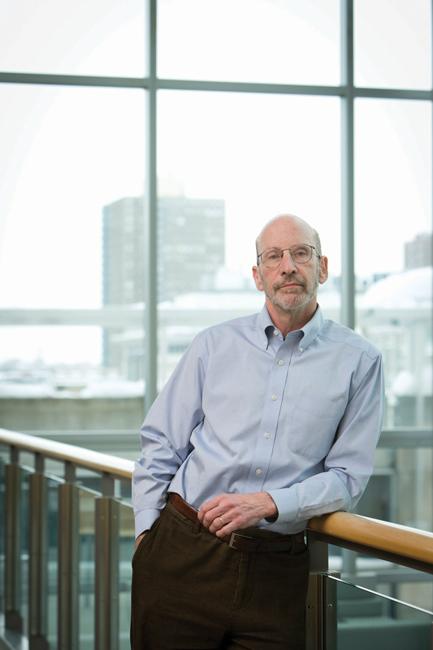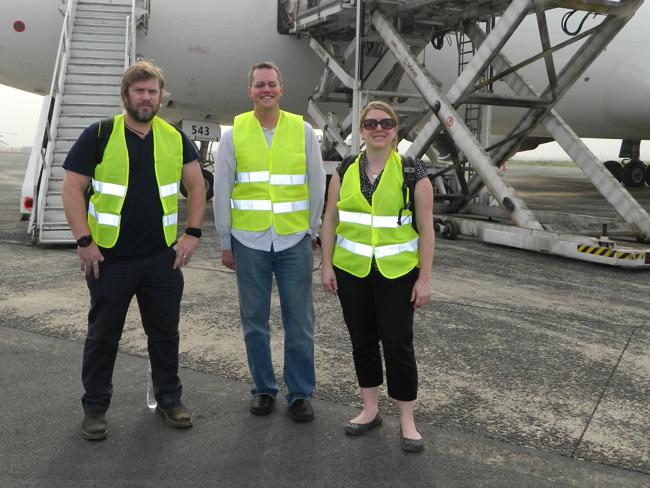A Common Foe
Members of the HMS community brought myriad skills to the fight against Ebola
- Feature

Last fall, as Ebola, a highly contagious and deadly hemorrhagic illness, tore through West Africa, devastating families and straining fragile health systems, infectious disease physician Megan Murray ’90 jumped into action. Like others at HMS, Murray, an HMS professor of global health and social medicine, director of the research core in the HMS Department of Global Health and Social Medicine, epidemiologist, and world-recognized expert in tuberculosis, began identifying urgent research questions raised by the epidemic and turned to HMS colleagues to help answer them.
“We involved a lot of individuals who were working extraordinarily hard,” Murray says.
Throughout the HMS community, clinicians, bench scientists, data specialists, global health and humanitarian crisis experts, and others brought their knowledge to bear on the largest Ebola epidemic in history.
Discovered in 1976 near the Ebola River in Central Africa, the virulent virus was a rarity in West Africa. Yet, in December 2013, an unidentified virus killed a toddler in Guinea. The infectious agent spread quietly into neighboring Liberia and Sierra Leone and then erupted, spreading rapidly within the three countries, aided by poor communication, limited medical infrastructures, social forces, and a tentative international response. By spring 2014, the disease had been verified as Ebola. By this past March, the virus had sickened an estimated 24,700 people and killed more than 10,000 in West Africa. Since its dire high point, the number of new infections has been steadily falling, and responders are working toward the magic number of cases: zero.
Although the epidemic’s intensity has diminished, the work of HMS researchers in Boston and Africa has not. Scientists and clinicians such as those profiled here are continuing their efforts to contain the disease and to prevent future outbreaks through better diagnosis, treatment, health systems, and access to quality medical care.
Portals Being Stormed
Long before the Ebola virus became daily news, James Cunningham, an HMS associate professor of medicine (microbiology and molecular genetics) at Brigham and Women’s Hospital, had been studying how enveloped viruses like Ebola enter cells and wreak havoc. Discoveries in Cunningham’s lab throughout the past decade identified several essential steps in the complex process by which the Ebola virus is transmitted, including the identification of compounds that block penetration of the virus into cells.

Although these findings have contributed to our overall understanding of the Ebola viruses, it was only recently—as the epidemic in West Africa intensified interest in finding effective therapies and vaccines—that Cunningham’s work took a significant step toward drug development. In January, Harvard University and Brigham and Women’s licensed two classes of Ebola inhibitors to a biotechnology company in Canada for development.
One class targets a host protein, Niemann-Pick C1, which normally transports cholesterol into cells. Cunningham and his colleagues found that Niemann-Pick C1 is an essential part of the portal that Ebola uses to enter cells.
“If Niemann-Pick C1 is absent or blocked, infection doesn’t occur,” says Cunningham. “That gives us confidence that it is a good drug target.”
A second family of compounds disrupts Ebola’s path to the lysosome, the cell compartment containing Niemann-Pick C1; a major goal is to understand how this second family of compounds works.
Cunningham’s team described the critical role of Niemann-Pick C1 in Ebola infection in a 2011 paper in Nature. That report built on the team’s earlier research showing that specific proteases in the lysosome help Ebola enter cells. Their findings coincided with those in a separate Nature study published by colleague Sean Whelan, an HMS professor of microbiology and immunobiology, whose lab used a genetic approach (rather than Cunningham’s chemical biology one) to identify the proteins required for infection. The studies refined our understanding of Ebola by revealing why sequential encounters with host protease and Niemann-Pick C1 are essential for infection.
Cunningham hopes that the compound that targets Niemann-Pick C1 can be developed into a low-cost and easily produced oral treatment for Ebola, especially given the absence of proven therapies beyond supportive care with IV fluids. There are currently no antiviral medicines or vaccines approved by the U.S. Food and Drug Administration for Ebola, although several are being tested.
“Producing an effective new therapy for Ebola would be incredibly gratifying for my colleagues and me,” says Cunningham. “That possibility provides an additional strong incentive to continue our studies.”
Safety First
Michelle Niescierenko, an HMS instructor in pediatrics and director of the Global Health Program at Boston Children’s Hospital, usually spends four or five months a year in Liberia as part of an academic consortium, which is led by the University of Massachusetts Medical School and includes Boston Children’s, that works to strengthen medical education. She was in Liberia in June 2014 teaching advanced life support to medical residents when the Ebola virus was diagnosed in residents of a crowded neighborhood in Monrovia, the capital city. An earlier outbreak in the country was thought to have been contained months before, so the news of new infections made her heart sink. Liberian health care workers already faced routine shortages of gloves, gowns, and other infection-control essentials, and “we knew the system was never going to be able to cope with the need for Ebola protection,” says Niescierenko. The disease spreads in humans through contact with infected bodily fluids and causes fever, severe headache, bleeding, vomiting, diarrhea, and, often, death.

During this past summer while Niescierenko was in Boston, Ebola continued to spread through West Africa. Health care facilities, overwhelmed by the volume of patients and the risk of Ebola infection, closed. Individuals with conditions other than Ebola were afraid to seek care, and hundreds of providers—including several of Niescierenko’s Liberian friends and coworkers—contracted the virus. “When we returned in November, it was like the sky was still falling,” Niescierenko recalls.
She dove in, coordinating a relief effort through the consortium to restore basic health care by reopening hospitals and training and protecting frontline staff. “We’ve focused on keeping Ebola out of hospitals and on teaching providers how to practice safely,”she says. An intervention she co-designed sends teams of Liberian trainers, including doctors, nurses, midwives, and water and sanitation engineers, to twenty-two government hospitals across the country, and the team coaches hospital staff on proper triage and other safe practice standards. Each hospital receives a three-month stock of personal protective equipment (PPE) and other infection-control gear as well as follow-up visits or check-in calls.
In January, Niescierenko saw encouraging results at Redemption Hospital in Monrovia; there, the contagiousness of Ebola had made caregivers wary of touching patients. As she was walking by the pediatric ward, she looked through the window and saw two nurses “wearing proper PPE—gowns, gloves, and shields to protect their faces—and they were putting an IV line into a very sick baby who, probably, nobody would have touched two weeks earlier,” she says. “So the training makes a difference. It’s ultimately going to help make their system stronger.”
The Crisis at Home
For the past eight years, Last Mile Health, a nonprofit led by Rajesh Panjabi, an HMS instructor in medicine and associate physician in the Division of Global Health Equity at Brigham and Women’s, has been working in Liberia, delivering primary care to remote rainforest villages. Last Mile Health trains and equips community health workers to treat malaria, pneumonia, complications of childbirth, and other high-mortality conditions within their local communities.

A Liberian native, Panjabi co-founded the organization in 2007 to serve those his family had left behind when they escaped that nation’s civil war in 1990, when he was nine years old. “After the conflict, the country had fifty-one physicians for about four million people,” says Panjabi.
The organization’s mission gained urgency after Liberia announced its first suspected Ebola cases in March 2014; by July, the group was coordinating response efforts in partnership with the Liberian government. To illustrate Ebola’s destructive nature, Panjabi relates the story of one woman in Rivercess County, one of two counties where Last Mile Health works. “She was infected with Ebola when she left Monrovia in late October. She traveled ten to fifteen hours into the rainforest in Rivercess, then fell ill. The community didn’t have the resources to bury her safely. Fourteen days later, fourteen people had died of Ebola, forty people were infected, and ninety were exposed. All this happened way in the heart of the rainforest.”
For its part, the organization has trained 340 health facility staff and more than 900 community health workers and other villagers in identifying and tracking Ebola—including going door-to-door to identify sick people, get them treatment, and trace their contacts to prevent further contamination. Last Mile Health also has continued dispensing malaria tablets, antibiotics, prenatal care, and other essential services through its network of local health workers.
The government of Liberia plans to dramatically expand the country’s health workforce, including scaling up efforts like Last Mile Health’s community-based model, according to Panjabi. “If that happens, we’ll have a health worker in every village in every part of the country. That’s the kind of thing that stops threats like Ebola from becoming threats to everyone everywhere.”
Ground Control
Do some people who harbor Ebola virus stay healthy? What’s the lag time between showing symptoms and being infectious? Will survivors face long-term physical and social consequences?
According to Murray, answering these questions will help elucidate how Ebola tightens its grip on individuals and populations and, researchers hope, lead to better treatment outcomes and containment practices. The work complements that of others in the School’s Department of Global Health and Social Medicine, including the on-the-ground clinical activities of Paul Farmer ’88, the Kolokotrones University Professor of Global Health and Social Medicine, and Partners In Health, the organization Farmer co-founded.
Capturing meaningful patient data is particularly challenging in the chaotic environment of a West Africa Ebola clinic, she adds, where patients are gravely sick; lab capacity, electricity, and Internet service are limited; caregivers must wear hot and cumbersome protective gear; and even paper with clinical notes has to be destroyed because it is contaminated.
In a related effort, Eric Perakslis, the former executive director of the HMS Center for Biomedical Informatics, has collaborated with Médecins Sans Frontières and Google Crisis Response on a clinical data management tool that allows providers in highly infectious or toxic environments to document patient encounters accurately, safely, and quickly.“It’s a complete electronic health record in a box,” says Perakslis. This winter, he spent two weeks in Sierra Leone piloting the system, which runs on Android tablets.

Murray’s team also has several Ebola-related clinical studies under way. One, which launched in February and involves Nira Pollock, an HMS assistant professor of medicine at Beth Israel Deaconess Medical Center, will examine the accuracy of point-of-care diagnostic tests that provide immediate results, a major advantage in a region with scarce laboratory services. A second project will track the experience of Ebola survivors for eighteen months after treatment, exploring such factors as immune response, health problems, and social integration.
The Ebola epidemic in West Africa waned faster than expected, so one lesson going forward, says Murray, is to activate data collection systems as quickly as possible. “Ebola is a microcosm of what we do in other settings, but faster and more intense,” she says. “The logistics we’ve learned dealing with Ebola will apply to everything we do.”
Debra Bradley Ruder is a Massachusetts-based education and health care writer.
Images, from top: Stephen Belcher/Minden Pictures/Corbis; John Soares, Michelle Niescierenko, Shane Snider, John Soares